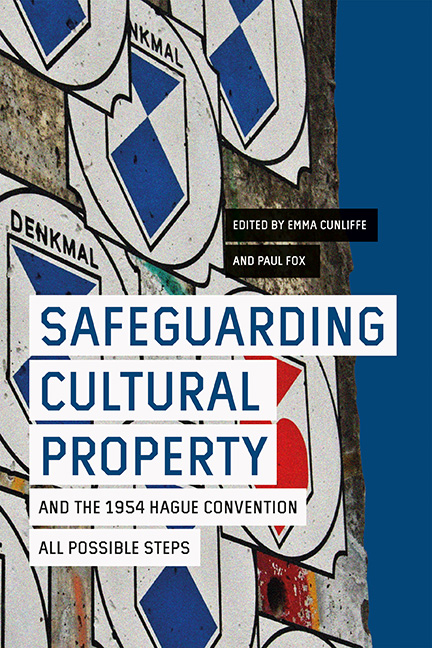Book contents
- Frontmatter
- Contents
- List of Illustrations
- List of Contributors
- Plate Section
- Acknowledgements
- List of Abbreviations
- Preface: The Blue Shield and the Protection of the World's Cultural Property – Preparing in Peace for Conflict
- Part I Safeguarding – Reassessing the Field
- Part II Historical Perspectives
- Part III Current Issues in Legal Implementation
- Part IV The Hague Convention in Practice Today: Tools and Approaches
- Appendix 1 The Hague Convention for the Protection of Cultural Property in the Event of Armed Conflict with Regulations for the Execution of the Convention 1954
- Appendix 2 Regulations for the Execution of the Convention for the Protection of Cultural Property in the Event of Armed Conflict
- Appendix 3 Resolutions of the 1954 Hague Conference
- Appendix 4 Second Protocol to the Hague Convention of 1954 for the Protection of Cultural Property in the Event of Armed Conflict 1999
- Appendix 5 Additional Protocols (1977) to the Geneva Conventions (1949) (Extracts)
- Index
- HERITAGE MATTERS
Preface: The Blue Shield and the Protection of the World's Cultural Property – Preparing in Peace for Conflict
Published online by Cambridge University Press: 26 May 2022
- Frontmatter
- Contents
- List of Illustrations
- List of Contributors
- Plate Section
- Acknowledgements
- List of Abbreviations
- Preface: The Blue Shield and the Protection of the World's Cultural Property – Preparing in Peace for Conflict
- Part I Safeguarding – Reassessing the Field
- Part II Historical Perspectives
- Part III Current Issues in Legal Implementation
- Part IV The Hague Convention in Practice Today: Tools and Approaches
- Appendix 1 The Hague Convention for the Protection of Cultural Property in the Event of Armed Conflict with Regulations for the Execution of the Convention 1954
- Appendix 2 Regulations for the Execution of the Convention for the Protection of Cultural Property in the Event of Armed Conflict
- Appendix 3 Resolutions of the 1954 Hague Conference
- Appendix 4 Second Protocol to the Hague Convention of 1954 for the Protection of Cultural Property in the Event of Armed Conflict 1999
- Appendix 5 Additional Protocols (1977) to the Geneva Conventions (1949) (Extracts)
- Index
- HERITAGE MATTERS
Summary
[When fighting broke out in former Yugoslavia in the early 1990s] the reaction of the professional community was uncoordinated and inefficient. For example, multiple missions were mounted to Sarajevo, and while doubtless helpful in showing solidarity with professional colleagues there, these were generally carried out in ignorance of each other, and valuable opportunities for sharing information and resources were missed … There was clearly scope for increased co-operation.
George McKenzie, IFLA representative co-founder of ICBS (2000, 5)But what does cooperation mean? Why does it matter? And what form should it take? These are questions with no easy answer, but which, as President of the Blue Shield, an international organisation dedicated to the protection of heritage in armed conflict, I grapple with on a daily basis, and which are central to the discussions within the following pages.
Cultural property protection during armed conflict is a hard task to achieve – practical results must be delivered under pressure in complex circumstances. Resources are limited, and multiple demands compete for attention. The situation will be constantly changing, and pre-planning, while essential, may have to give way to flexibility in the face of emerging circumstances. When they occur, such situations require not only strong leadership to achieve effective outcomes, but significant pre-planning to assess possible risks and threats and plan for them as far as possible, to minimise the chances of unexpected events resulting in the loss of cultural heritage. In cultural property protection, that means a multi-sectoral approach is essential, as embodied in the 1954 Hague Convention for the Protection of Cultural Property in the Event of Armed Conflict and its two Protocols, and as examined in this volume. The peacetime activities recommended in the Convention – safeguarding measures at sites, listing of key sites for greater protection, preparation of storage facilities for moveable cultural property and of transports to such refuges, and training of civil and military authorities, amongst a number of others – cannot be realised without planning, coordination, and effective leadership. The Convention allocates such responsibilities to its high contracting parties and their designated competent authorities, but they were not meant to work alone.
- Type
- Chapter
- Information
- Safeguarding Cultural Property and the 1954 Hague ConventionAll Possible Steps, pp. xvii - xxiiPublisher: Boydell & BrewerPrint publication year: 2022



